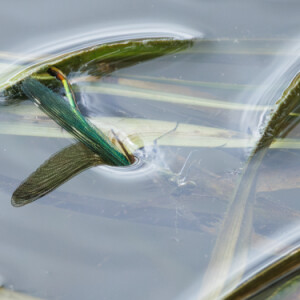Supervision
This afternoon I spent ten minutes watching in fascination as a female Banded Demoiselle laid her eggs in the floating and submerged vegetation close to one of the fishing pegs at Cleeve Prior Mill. I knew from reading my Brooks & Cham field guide that ovipositing Banded Demoiselles will often submerge completely in search of a substrate that meets their approval*, and I did once watch a half-submerged female almost lose her life to the two males fighting for possession of her, but I'd never witnessed anything quite like this before.
This female was so focused on probing the vegetation and laying her eggs that she seemed uncaring, or maybe even unaware, as to which way up she was. A couple of times I saw her virtually submerge, with only the ends of her wings and the tip of her abdomen out of the water, testing leaves that were lying above the surface. Every now and then, to my relief, she would right herself and emerge fully into the fresh air, at which point her partner, who mostly watched from a perch on a nearby emergent stem, would immediately fly over and land on her - apparently encouraging her to get back down in the river and get on with the job, though more probably just guarding his investment from other nearby males. My second photo shows one of the times when she was effectively upside-down in the water but ovipositing at the surface; and there's a longer sequence of images here, if you'd like to see more.
I would love to be able to tell you that this story has a happy ending, but I'm afraid I'm going to have to leave us all in suspense. Just after I took the last photo of my Facebook sequence I was distracted for a minute by the arrival of a tandem pair of White-legged Damselflies, and by the time I'd photographed them and looked back toward the Banded Demoiselles, the male was back on his perch and the female had disappeared. And very shortly after that, as I was still watching anxiously for her to reappear, half a dozen mallards arrived and began rummaging through the vegetation where she'd been laying, in search of food. I'd like to think that she was safely out of the water by then, maybe ovipositing somewhere else, but I rather fear she may have paid the ultimate price for her commitment to giving her offspring the best possible start in life.
* The book states - rather perfunctorily, I think, "...they are able to respire whilst submerged because they trap a layer of air between their wings which is continuous with their tracheal system." Which is fine as far as it goes, but still has me asking How though???


Comments
Sign in or get an account to comment.


